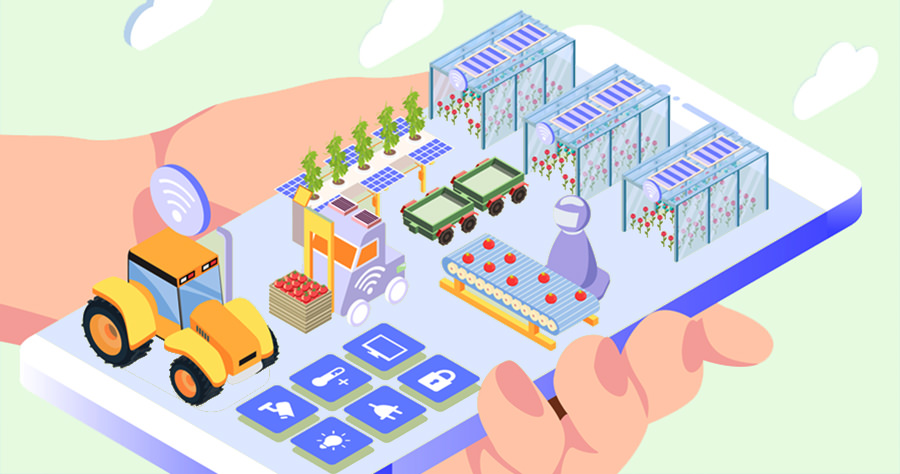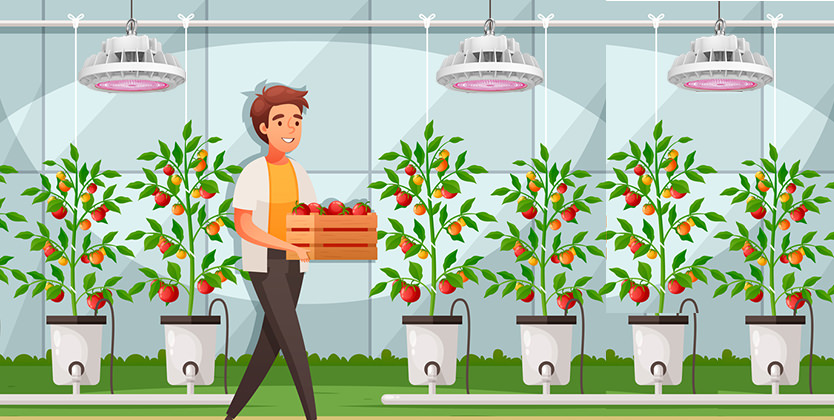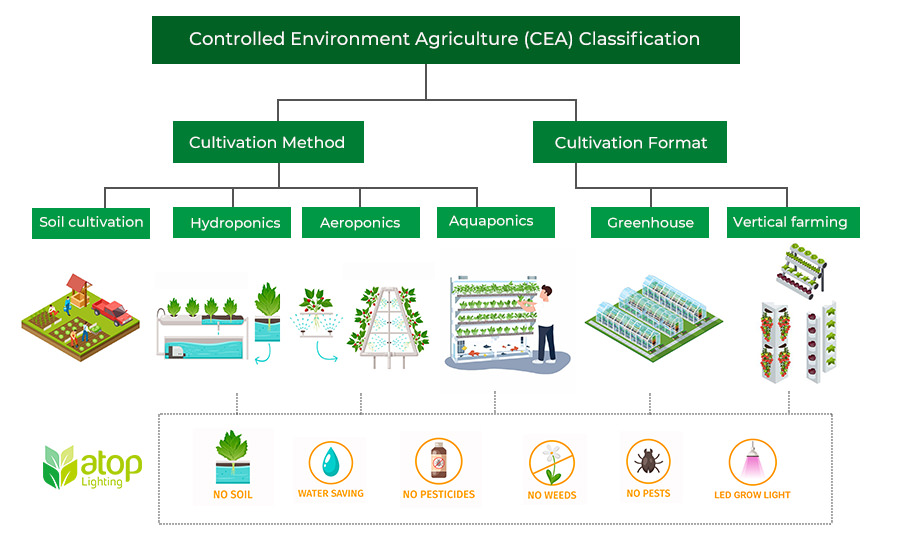What Is CEA in Agriculture

It seems that ‘CEA’ is popular these days and it sounds familiar to most people in the filed related with agriculture. But you may scratch you head about what is CEA in agriculture. CEA is an abbreviation of ‘Controlled Environment Agriculture’. In simple words, CEA is a high-tech approach to gain a more sustainable food and plants production and fight against climate change and shortage of arable land. A large number of researches of CEA are made to find out the optimal environment condition to food and plants growth. Let’s take a look at a more comprehensive instruction about CEA in agriculture.
What is CEA
CEA is an acronym for ‘Controlled Environment Agriculture’. CEA also known as indoor farming. The existence of CEA could date back to the 19th century, development of the first modern greenhouse. Over years, CEA is gaining growing attentions under the condition of decreasing global water and arable land resources. With the development of technologies, CEA is becoming more and more sustainable and profitable. CEA cultivates plants in a managed environment by controlling all factors associated with growing, such as temperature, light, humidity, carbon dioxide, and airflow. For example, CEA can reach ester lily for the market by controlling temperature. Additionally, CEA protects plants from pets, disease, and overused pesticide. From providing the optimal growing condition for plants, grower can reap higher productivity and better quality. CEA is used for various plants while vegetables and ornamental are the major applications. Vegetables includes tomatoes, peppers, cucumbers and others. Ornamental like bedding plants, perennials, and cut flower are applied to CEA. Fruits like strawberries are commonly grown via CEA as well. Besides, legal cultivation of cannabis such as medicinal cannabis makes use of CEA.
CEA is mainly classified by cultivation method and cultivation format. Hydroponics, aeroponics, aquaponics, and soil cultivation are included in cultivation methods. Greenhouse and vertical farming are the two cultivation format. There is a table about the classifications of controlled environment agriculture and their overview.
|
Classification |
Overview |
|
|
Cultivation method |
Soil cultivation |
Using soil for cultivation Soil content and other factors are controlled |
|
Hydroponics |
Growing plants free of soil Root of plants are immersed in the water with nutrient Generally used for growing tomatoes |
|
|
Aeroponics |
Growing plants without liquid or soil Spray nutrient solution in air chambers or pumps Suitable for growing plants in multi-stage |
|
|
Aquaponics |
A combination of conventional aquaculture and hydroponics Fish produce nutrient-rich waste to feed plants PH and ammonia levels should be carefully monitored |
|
|
Cultivation format |
Greenhouse |
Sunlight is the main light source Artificial lights provide supplement light Constructed with glass or plastic ceilings |
|
Vertical farming |
Artificial light like LED grow light is the sole light source in general Further classified by location: building-based, container, and kitchen garden All environment factors are fully controlled |
|
Benefits & challenges of CEA
Advancement of technology improve the controlling efficiency of growth environment. Sensors are installed in CEA, detecting the content of water and fertilizer for further conduction. Cameras are also used to monitor growing condition of plants. Other tools like thermal imaging, hydrometer, and thermometer, measure temperature and humidity. All information can be collected and integrated in smart phone Apps. Moreover, factors including water, fertilizer, temperature, humidity, lighting, etc, are adjustable through Apps, targeting real-time and remote monitor. Benefits of CEA are as followed:
- As factors of growth environment are controllable, there are less waste of resource and energy. CEA is positive for environment due to the less use of water, pesticides, fertilizers, etc.
- Stronger resistances to climate change. Indoor growing enable plants grown apart from bad weather, extreme temperature, and pest.
- Increase production and make year-round production available, release the stress of food supply with the increase of population and the reduce of arable land.
- Urban farms ensure the speedy distribution, cut down delivery cost and time. Lower the price of food and other plants while keeping fresh for customers.
- Boost local economy and consumption. Foods and plants are cultivated and sold locally, offering more work opportunities for unemployed people and stimulate consumption.
There is no doubt that CEA brings a lot of benefits for human, but it also faced with challenges. The main challenge in CEA is the high levels of cost. Construction, operation, and maintenance are of high cost in CEA.
Sensors, equipment, and measurement tools are more expensive than conventional open field cultivation. In addition, labor cost for construction of greenhouse or vertical farms are of high expense.
Electricity bill is the highest among all operational bills in indoor farming, especially vertical farming. Light is one of the key controlled factors in CEA. To provide sufficient lights for plants, artificial lights are working an average of 16 hours per day. The high cost of electricity bill gains growing attentions and motivates the development of energy-saving and cost-effective lighting strategies, which are able to maximize plant growth while minimize electricity bill.
We all know that light is critical for plant growth. Plants absorb lights and respond with photosynthesis and photomorphogenesis. Aspects of light, including light intensity, light quality, daily light integral, and light direction (upwards, inter-lighting, and downward), influence plant growth. Light intensity and quality can affect color, aroma, flavor, and morphology (height, length, branching, etc). Daily light integral is relative with phenolic and anthocyanin content.

Innovation of LED grow lights offers an excellent lighting solution for CEA. LED grow lights can provide customized light spectrum to meet the needs of growing different species, making year-round production to reality. Moreover, LED grow lights can be controlled (on or off) simultaneously or partly at specific time. Energy saving up to 80% is possible by using LEDs instead of conventional light sources. LED grow lights enhance plant growth and quality, achieving lower cost but higher output lighting solution.
Atop is specialized in providing LED grow light solution for every specific growing project. Click here and get your own FREE lighting design.
Maintenance charge in CEA can’t be ignored. Cost of employment and training of labor exists the whole CEA. Workers in CEA should have the basic knowledge of cultivation. Thus, the higher requirements of employment cause higher costs. As CEA is high-tech, workers are supposed to learn how to use the equipment and how to solve the problems when breakdown occurs. Besides, if there is anything wrong with equipment, repair is not only require high cost but also affect the plant growth and the normal running of cultivation.
Tremendous efforts are devoted to meet the challenges and enhance benefits. We are hopefully to expect that CEA will bring better future for humans. By the time, cultivation and food supply will not be limited by harsh weather and arable shortage any more.
Appendix: To help you learn about CEA easier, here is a picture of the classification of CEA in agriculture.


